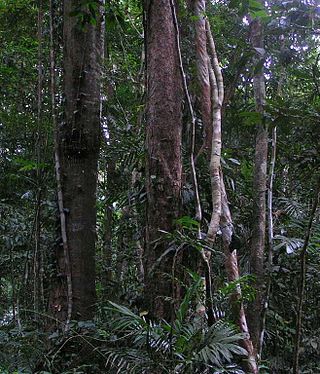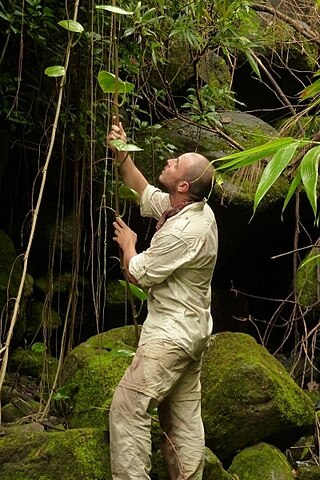Related Research Articles
Abiotic stress is the negative impact of non-living factors on the living organisms in a specific environment. The non-living variable must influence the environment beyond its normal range of variation to adversely affect the population performance or individual physiology of the organism in a significant way.

An ecosystem is a system that environments and their organisms form through their interaction. The biotic and abiotic components are linked together through nutrient cycles and energy flows.

Photosynthesis is a biological process used by many organisms to convert light energy into chemical energy, which is stored in organic compounds that can later be metabolized through cellular respiration to fuel the organism's activities. The term usually refers to oxygenic photosynthesis, where oxygen is produced as a byproduct and some of the chemical energy produced is stored in carbohydrate molecules such as sugars, starch, glycogen, and cellulose, which are synthesized from an endergonic reaction of carbon dioxide with water. Organisms that perform photosynthesis are called photoautotrophs; most plants, algae, and cyanobacteria are photoautotrophs. Photosynthesis is largely responsible for producing and maintaining the oxygen content of the Earth's atmosphere, and it supplies most of the biological energy necessary for complex life on Earth.

Decomposition or rot is the process by which dead organic substances are broken down into simpler organic or inorganic matter such as carbon dioxide, water, simple sugars and mineral salts. The process is a part of the nutrient cycle and is essential for recycling the finite matter that occupies physical space in the biosphere. Bodies of living organisms begin to decompose shortly after death. Animals, such as earthworms, also help decompose the organic materials. Organisms that do this are known as decomposers or detritivores. Although no two organisms decompose in the same way, they all undergo the same sequential stages of decomposition. The science which studies decomposition is generally referred to as taphonomy from the Greek word taphos, meaning tomb. Decomposition can also be a gradual process for organisms that have extended periods of dormancy.
This glossary of ecology is a list of definitions of terms and concepts in ecology and related fields. For more specific definitions from other glossaries related to ecology, see Glossary of biology, Glossary of evolutionary biology, and Glossary of environmental science.

C4 carbon fixation or the Hatch–Slack pathway is one of three known photosynthetic processes of carbon fixation in plants. It owes the names to the 1960s discovery by Marshall Davidson Hatch and Charles Roger Slack.

The natural environment or natural world encompasses all living and non-living things occurring naturally, meaning in this case not artificial. The term is most often applied to Earth or some parts of Earth. This environment encompasses the interaction of all living species, climate, weather and natural resources that affect human survival and economic activity. The concept of the natural environment can be distinguished as components:
Realized niche width is a phrase relating to ecology, is defined by the actual space that an organism inhabits and the resources it can access as a result of limiting pressures from other species. An organism's ecological niche is determined by the biotic and abiotic factors that make up that specific ecosystem that allow that specific organism to survive there. The width of an organism's niche is set by the range of conditions a species is able to survive in that specific environment.
A limiting factor is a variable of a system that causes a noticeable change in output or another measure of a type of system. The limiting factor is in a pyramid shape of organisms going up from the producers to consumers and so on. A factor not limiting over a certain domain of starting conditions may yet be limiting over another domain of starting conditions, including that of the factor.

An aquatic ecosystem is an ecosystem found in and around a body of water, in contrast to land-based terrestrial ecosystems. Aquatic ecosystems contain communities of organisms—aquatic life—that are dependent on each other and on their environment. The two main types of aquatic ecosystems are marine ecosystems and freshwater ecosystems. Freshwater ecosystems may be lentic ; lotic ; and wetlands.

Forest ecology is the scientific study of the interrelated patterns, processes, flora, fauna and ecosystems in forests. The management of forests is known as forestry, silviculture, and forest management. A forest ecosystem is a natural woodland unit consisting of all plants, animals, and micro-organisms in that area functioning together with all of the non-living physical (abiotic) factors of the environment.
The light compensation point (Ic) is the light intensity on the light curve where the rate of photosynthesis exactly matches the rate of cellular respiration. At this point, the uptake of CO2 through photosynthetic pathways is equal to the respiratory release of carbon dioxide, and the uptake of O2 by respiration is equal to the photosynthetic release of oxygen. The concept of compensation points in general may be applied to other photosynthetic variables, the most important being that of CO2 concentration – CO2 compensation point (Γ).Interval of time in day time when light intensity is low due to which net gaseous exchange is zero is called as compensation point.
The following outline is provided as an overview of and topical guide to ecology:

Soil respiration refers to the production of carbon dioxide when soil organisms respire. This includes respiration of plant roots, the rhizosphere, microbes and fauna.
Aquatic science is the study of the various bodies of water that make up our planet including oceanic and freshwater environments. Aquatic scientists study the movement of water, the chemistry of water, aquatic organisms, aquatic ecosystems, the movement of materials in and out of aquatic ecosystems, and the use of water by humans, among other things. Aquatic scientists examine current processes as well as historic processes, and the water bodies that they study can range from tiny areas measured in millimeters to full oceans. Moreover, aquatic scientists work in Interdisciplinary groups. For example, a physical oceanographer might work with a biological oceanographer to understand how physical processes, such as tropical cyclones or rip currents, affect organisms in the Atlantic Ocean. Chemists and biologists, on the other hand, might work together to see how the chemical makeup of a certain body of water affects the plants and animals that reside there. Aquatic scientists can work to tackle global problems such as global oceanic change and local problems, such as trying to understand why a drinking water supply in a certain area is polluted.
In biology and ecology, a resource is a substance or object in the environment required by an organism for normal growth, maintenance, and reproduction. Resources box can be consumed by one organism and, as a result, become unavailable to another organism. For plants key resources are light, nutrients, water, and place to grow. For animals key resources are food, water, and territory.
This glossary of biology terms is a list of definitions of fundamental terms and concepts used in biology, the study of life and of living organisms. It is intended as introductory material for novices; for more specific and technical definitions from sub-disciplines and related fields, see Glossary of cell biology, Glossary of genetics, Glossary of evolutionary biology, Glossary of ecology, Glossary of environmental science and Glossary of scientific naming, or any of the organism-specific glossaries in Category:Glossaries of biology.

A vertical ecosystem is an architectural gardening system developed by Ignacio Solano from the mur vegetal created by Patrick Blanc. This new approach enhances the previous archetype of mur vegetal and considers the relationship that exists between a set of living organisms, biocenosis, inhabiting a physical component, biotope. The system is based on the automated control of nutrients and plant parameters of the original wall, adding strains of bacteria, mycorrhizal fungi and interspecific symbiosis in plant selection, creating an artificial ecosystem from inert substrates. The system was created in 2007 and patented in 2010.
The evolution of photosynthesis refers to the origin and subsequent evolution of photosynthesis, the process by which light energy is used to assemble sugars from carbon dioxide and a hydrogen and electron source such as water. The process of photosynthesis was discovered by Jan Ingenhousz, a Dutch-born British physician and scientist, first publishing about it in 1779.

Photosynthesis converts carbon dioxide to carbohydrates via several metabolic pathways that provide energy to an organism and preferentially react with certain stable isotopes of carbon. The selective enrichment of one stable isotope over another creates distinct isotopic fractionations that can be measured and correlated among oxygenic phototrophs. The degree of carbon isotope fractionation is influenced by several factors, including the metabolism, anatomy, growth rate, and environmental conditions of the organism. Understanding these variations in carbon fractionation across species is useful for biogeochemical studies, including the reconstruction of paleoecology, plant evolution, and the characterization of food chains.
References
- ↑ Ricklefs, R.E. 2005. The Economy of Nature, 6th edition. WH Freeman, USA.
- ↑ Chapin, F.S. III, H.A. Mooney, M.C. Chapin, and P. Matson. 2011. Principles of terrestrial ecosystem ecology. Springer, New York.
- ↑ Water Quality Vocabulary. ISO 6107-6:1994.
- ↑ Hogan, C. Benito (2010). "Abiotic factor". Encyclopedia of Earth. Washington, D.C.: National Council for Science and the Environment. Archived from the original on 2013-06-08.
- ↑ "Ocean Abiotic Factors" (PDF). National Geographic Society. 2011.
- ↑ Wang, Chuali; Guo, Longyun; Li, Yixue; Wang, Zhuo (2012). "Systematic Comparison of C3 and C4 Plants Based on Metabolic Network Analysis". BMC Systems Biology. 6 (59): S9. doi: 10.1186/1752-0509-6-S2-S9 . PMC 3521184 . PMID 23281598.
- ↑ "Rubisco and C4 Plants" (PDF). RSC: Advancing the Chemical Sciences. RSC. Archived from the original (PDF) on 2016-03-24. Retrieved 2017-05-05.
- ↑ "Abiotic Components". Department of Biodiversity and Conservation Biology, University of the Western Cape. Archived from the original on 2005-04-25.
- ↑ Dunson, William A. (November 1991). "The Role of Abiotic Factors in Community Organization". The American Naturalist. 138 (5): 1067–1091. doi:10.1086/285270. JSTOR 2462508. S2CID 84867707.